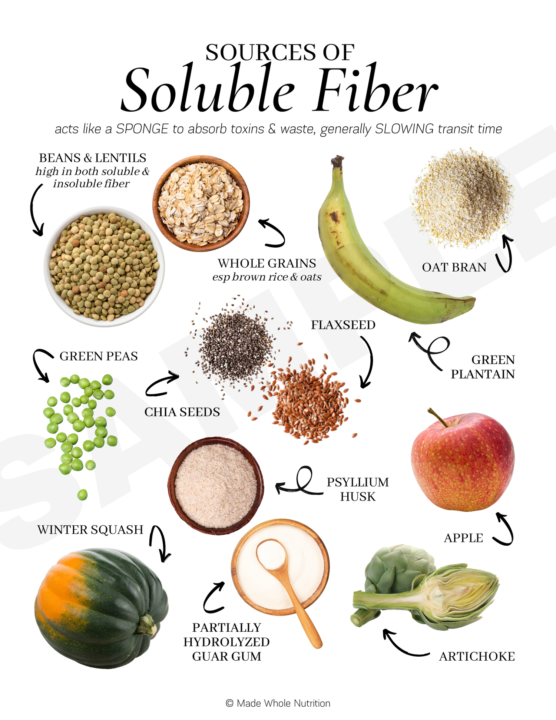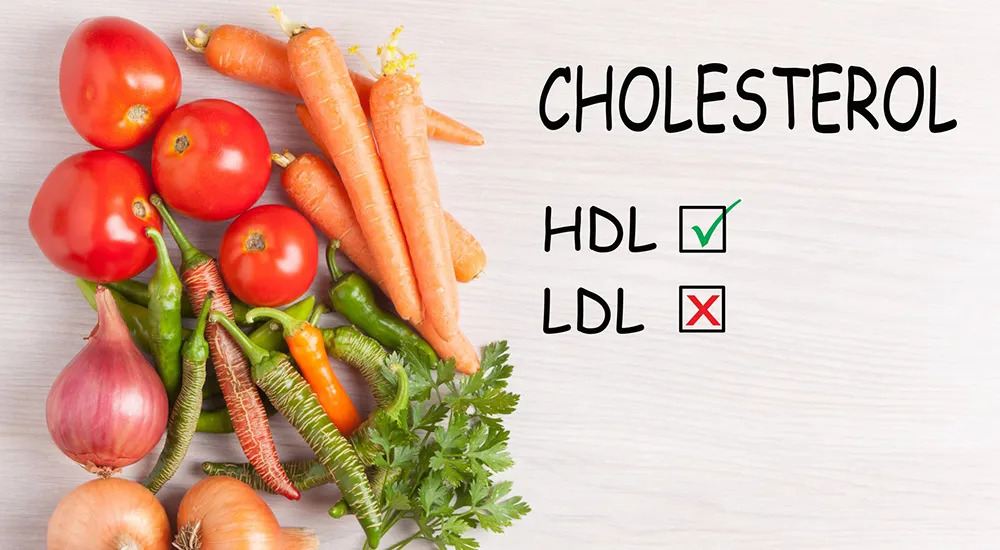1. Healthy Diet
Focus on a diet rich in fruits, vegetables, whole grains, and lean proteins. Reduce saturated and trans fats found in fried and processed foods. Incorporate healthy fats like those from nuts, seeds, and avocados.

A healthy diet for managing cholesterol typically includes:
- Fruits and Vegetables: Aim for a variety of colorful fruits and vegetables. They’re rich in vitamins, minerals, and antioxidants that can help reduce cholesterol.
- Whole Grains: Opt for whole grains like brown rice, quinoa, whole wheat bread, and oats. They contain fiber that can help lower LDL cholesterol.
- Lean Proteins: Choose lean meats like skinless poultry, fish (especially fatty fish like salmon), tofu, beans, and legumes. They provide protein without adding excess saturated fats.
- Healthy Fats: Incorporate sources of healthy fats like avocados, nuts, seeds, and olive oil. These fats can improve cholesterol levels.
- Limit Saturated and Trans Fats: Cut back on foods high in saturated and trans fats, such as fatty cuts of meat, full-fat dairy products, fried foods, and commercially baked goods.
- Reduce Added Sugars: Minimize foods and beverages with added sugars. Opt for natural sources of sweetness like fruits.
- Portion Control: Keep portions in check, especially with higher-calorie foods. Even healthy foods can contribute to weight gain if eaten in large amounts.
- Limit Salt Intake: Reduce sodium intake by choosing low-sodium options and limiting processed and packaged foods.
- Hydration: Drink plenty of water throughout the day. Water helps in various bodily functions and can aid in overall health.
- Balanced Meals: Strive for balanced meals that include a mix of carbohydrates, proteins, and healthy fats to maintain steady energy levels and promote overall health.
Remember, individual dietary needs can vary. It’s essential to consider personal health conditions and consult with a healthcare professional or a registered dietitian for personalized dietary advice.
2. Increase Soluble Fiber
Foods like oats, barley, legumes, and fruits such as apples and citrus can help lower LDL cholesterol.

Sure, soluble fiber is a type of fiber found in certain foods that dissolves in water to form a gel-like material in your digestive system. This type of fiber can help lower cholesterol levels by binding to cholesterol particles and carrying them out of your body before they can be absorbed into your bloodstream.
Foods rich in soluble fiber include:
- Oats: Oatmeal and oat bran are particularly high in soluble fiber.
- Barley: Both pearl barley and barley flour contain soluble fiber.
- Legumes: Beans, lentils, chickpeas, and peas are good sources of soluble fiber.
- Fruits: Certain fruits like apples, oranges, strawberries, and citrus fruits contain soluble fiber.
- Vegetables: Foods like Brussels sprouts, sweet potatoes, carrots, and broccoli are rich in soluble fiber.
When you eat foods high in soluble fiber, it can help lower LDL cholesterol levels in your bloodstream. It does this by reducing the absorption of cholesterol into your bloodstream from the foods you eat. Incorporating these foods into your diet can be a natural and effective way to manage cholesterol levels and promote heart health.
3. Regular Exercise {Lower Cholesterol Naturally}
Aim for at least 30 minutes of moderate-intensity exercise most days of the week. Exercise can help increase HDL cholesterol and lower LDL cholesterol.

Regular exercise involves engaging in physical activities on a consistent basis to benefit your overall health and well-being, including managing cholesterol levels.
Here’s how it helps:
- Cardiovascular Health: Activities like brisk walking, running, cycling, swimming, or dancing raise your heart rate and increase blood circulation. This helps improve the health of your heart and blood vessels.
- Cholesterol Management: Exercise can raise HDL (“good”) cholesterol levels while lowering LDL (“bad”) cholesterol. It also helps in controlling triglyceride levels, another type of fat in your blood.
- Weight Control: Regular physical activity helps burn calories and maintain a healthy weight. For some, weight loss achieved through exercise can positively impact cholesterol levels.
- Improved Blood Circulation: Exercise helps keep blood vessels flexible and open, reducing the risk of plaque buildup that can lead to heart disease.
- Stress Reduction: Physical activity triggers the release of endorphins, which are natural mood lifters. Regular exercise can reduce stress and promote better mental health.
- Better Sleep: Exercise can improve sleep quality, which is essential for overall health and can indirectly impact cholesterol levels.
The American Heart Association recommends at least 150 minutes of moderate-intensity aerobic exercise per week or 75 minutes of vigorous-intensity exercise, spread throughout the week. It’s important to choose activities you enjoy to make exercise a sustainable part of your routine. Always consult with a healthcare professional before starting any new exercise regimen, especially if you have any underlying health conditions.
Read more:
- How to Lower Cholesterol Without Medication | Inspira Health
- How to Easily Calculate Your BMI – Inspira Health
- How Many Calories in a Hot Dog – Inspira Health
4. Weight Management
Losing excess weight, especially around the midsection, can positively impact cholesterol levels.
Weight management involves maintaining a healthy weight through a balance of proper nutrition and regular physical activity.
Here’s how it helps with cholesterol levels:
- Cholesterol Regulation: Carrying excess weight, especially around the midsection, can increase LDL (“bad”) cholesterol levels and decrease HDL (“good”) cholesterol levels. Managing weight helps regulate these cholesterol levels.
- Healthy Eating: Maintaining a healthy weight often involves making mindful food choices, which can positively impact cholesterol. A balanced diet with appropriate portion sizes contributes to better cholesterol levels.
- Physical Activity: Exercise is a crucial component of weight management. It helps burn calories, maintain muscle mass, and improve overall health, including cholesterol levels.
- Reduced Risk of Heart Disease: Managing weight reduces the risk of developing heart-related issues, including high cholesterol, high blood pressure, and other conditions that contribute to heart disease.
- Lifestyle Habits: Healthy weight management often involves adopting healthier lifestyle habits, such as getting enough sleep, managing stress, and avoiding unhealthy behaviors like smoking, all of which can affect cholesterol levels.
Aiming for a healthy weight through a combination of nutritious eating and regular exercise can significantly impact cholesterol levels and overall cardiovascular health. Consulting with a healthcare provider or a registered dietitian can provide personalized guidance on weight management strategies tailored to individual needs.
5. Limit Alcohol Intake
Excessive alcohol can raise cholesterol levels. Moderation is key; limit alcohol consumption to recommended levels.
Limiting alcohol intake is an important step in managing cholesterol levels and overall health.
Here’s how alcohol can affect cholesterol:
- Increased Triglycerides: Alcohol consumption, especially in excess, can raise triglyceride levels, a type of fat in the blood, which is linked to higher risk of heart disease.
- Weight Gain: Alcoholic beverages are often high in calories and can contribute to weight gain. Excess weight can negatively impact cholesterol levels.
- Liver Health: Alcohol can affect the liver’s ability to regulate cholesterol levels and metabolize fats, potentially leading to imbalances in cholesterol.
- Blood Pressure: Regular alcohol consumption can raise blood pressure, which is a risk factor for heart disease and can affect cholesterol levels.
For those who choose to drink alcohol, it’s advisable to do so in moderation. Moderate drinking is defined as up to one drink per day for women and up to two drinks per day for men. However, it’s important to note that abstaining from alcohol altogether is the safest option, especially for individuals with certain health conditions or those at risk of heart disease.
Choosing healthier alternatives like water, herbal teas, or low-calorie beverages can be beneficial for managing cholesterol levels and overall well-being. Always consult a healthcare professional for personalized advice regarding alcohol consumption and its impact on cholesterol and health.
6. Quit Smoking
Smoking damages blood vessels, leading to atherosclerosis (hardening of arteries) which can raise cholesterol levels.
Quitting smoking is one of the most beneficial actions you can take for your overall health, including your cholesterol levels and heart health.
Here’s why quitting smoking matters:
- Cholesterol Levels: Smoking can lower HDL (“good”) cholesterol and increase LDL (“bad”) cholesterol, which contributes to the buildup of plaque in arteries.
- Heart Health: Smoking damages blood vessels and can accelerate the hardening of arteries, increasing the risk of heart disease and stroke.
- Risk Reduction: Quitting smoking reduces the risk of developing heart disease, improving overall cardiovascular health and potentially helping to manage cholesterol levels more effectively.
- Improved Circulation: Smoking cessation can improve blood circulation, allowing for better oxygenation of tissues and organs, supporting heart health.
- Long-Term Health: Quitting smoking not only benefits cholesterol levels and heart health but also reduces the risk of various other health issues, such as lung diseases, cancers, and respiratory problems.
It’s never too late to quit smoking, and the benefits of quitting start almost immediately. Support from healthcare professionals, cessation programs, and support groups can significantly increase the chances of successfully quitting. Making the decision to quit smoking is a powerful step toward better health, including improved cholesterol levels and reduced risk of heart-related problems.
7. Healthy Cooking Methods
Opt for baking, grilling, steaming, or roasting rather than frying. This helps reduce added fats and calories.
Healthy cooking methods are ways of preparing food that help maintain its nutritional value while minimizing added fats and calories. Here are some healthy cooking techniques:
- Grilling: Cooking on a grill allows excess fats to drip away from the food, resulting in a lower-fat final dish. It’s great for meats, fish, and vegetables.
- Baking or Roasting: These methods involve using the oven to cook food with minimal added fats. They can bring out natural flavors and caramelization without excessive oil.
- Steaming: Steaming food preserves its nutrients and natural flavors without adding any extra fat. It’s particularly useful for vegetables, fish, and dumplings.
- Sautéing or Stir-frying with Healthy Oils: Lightly sautéing or stir-frying food in a small amount of heart-healthy oils like olive oil or avocado oil can add flavor without excessive fat.
- Boiling or Poaching: These methods involve cooking food in water or flavorful broths. They are suitable for preparing fish, eggs, vegetables, and certain meats without added fats.
- Air Frying: Using an air fryer reduces the need for excessive oil while still achieving a crispy texture. It’s a healthier alternative to deep-frying.
- Using Herbs and Spices: Enhancing flavors with herbs, spices, citrus, and vinegar can reduce the need for added fats or salt in cooking.
By choosing these healthier cooking methods, you can reduce the amount of added fats and calories in your meals, making them more heart-friendly and conducive to managing cholesterol levels. Pairing these methods with a balanced diet can contribute to better overall health.
8. Use Healthy Oils
Replace unhealthy fats (like butter) with healthier options like olive oil, avocado oil, or canola oil.
Using healthy oils in cooking is a smart choice for promoting heart health and managing cholesterol levels. Here are some beneficial options:
- Olive Oil: Rich in monounsaturated fats, olive oil is known for its heart-healthy properties. It’s great for sautéing, roasting, or drizzling over salads.
- Avocado Oil: With a high smoke point, avocado oil is suitable for high-heat cooking like frying or grilling. It’s also rich in monounsaturated fats.
- Canola Oil: Low in saturated fats and high in monounsaturated fats, canola oil is versatile and suitable for various cooking methods, from baking to sautéing.
- Coconut Oil (in Moderation): While controversial due to its high saturated fat content, some believe that using virgin coconut oil in moderation may offer health benefits. It’s often used in baking and sautéing.
- Grapeseed Oil: High in polyunsaturated fats and with a high smoke point, grapeseed oil is suitable for high-heat cooking methods like frying and grilling.
When choosing healthy oils, consider their smoke points (the temperature at which they start to break down and produce smoke). Using oils with higher smoke points for high-heat cooking and those with more delicate flavors for lower-heat cooking methods can help retain their nutritional benefits and prevent the formation of harmful compounds. Incorporating these oils into your cooking can contribute to better heart health and help manage cholesterol levels.
9. Consider Plant Sterols and Stanols
These compounds, found in certain fortified foods or available as supplements, can help lower LDL cholesterol.
Plant sterols and stanols are natural compounds found in plants that have been shown to help lower LDL (“bad”) cholesterol levels. They have a similar structure to cholesterol and can block the absorption of cholesterol in the intestine, reducing the amount that enters the bloodstream.
Here’s how they work and how you can incorporate them:
- Natural Sources: Plant sterols and stanols are naturally present in small amounts in various plant-based foods such as fruits, vegetables, nuts, seeds, and whole grains.
- Fortified Foods: Many food products, like certain margarines, spreads, and some orange juices, are enriched with added plant sterols and stanols to increase their intake. These fortified products can be easily incorporated into your diet.
- Supplements: There are also dietary supplements available that contain concentrated forms of plant sterols and stanols. However, it’s important to consult with a healthcare professional before taking supplements to ensure they are safe and appropriate for your health needs.
Consuming around 2 grams of plant sterols or stanols per day, typically spread across meals, can help lower LDL cholesterol levels by about 5-15% when part of a healthy diet and lifestyle. They work best when included as part of a comprehensive approach to managing cholesterol, alongside a healthy diet, regular exercise, and other lifestyle modifications.
10. Stress Management
Chronic stress can affect cholesterol levels. Practice relaxation techniques like meditation, yoga, or deep breathing exercises.
Stress management is crucial for overall well-being and can have an impact on cholesterol levels and heart health.
Here’s why managing stress matters:
- Hormonal Impact: Chronic stress triggers the release of hormones like cortisol and adrenaline, which, when elevated over time, can affect cholesterol metabolism and contribute to higher cholesterol levels.
- Unhealthy Coping Habits: Stress can lead to unhealthy coping mechanisms such as overeating, poor food choices, smoking, or excessive alcohol intake, all of which can negatively impact cholesterol levels.
- Blood Pressure: Prolonged stress can elevate blood pressure, which is a risk factor for heart disease and can influence cholesterol levels.
- Behavioral Impact: Stress might lead to a less active lifestyle, affecting exercise habits. Regular physical activity helps manage cholesterol levels.
To manage stress effectively:
- Relaxation Techniques: Practice relaxation methods like deep breathing exercises, meditation, yoga, or mindfulness to reduce stress levels.
- Regular Exercise: Physical activity is a great stress reliever. Aim for regular exercise sessions to help manage stress and improve overall health, including cholesterol levels.
- Healthy Lifestyle Habits: Eat a balanced diet, get adequate sleep, and prioritize time for activities you enjoy to help alleviate stress.
- Seek Support: Talking to friends, family, or a professional counselor can provide emotional support and help manage stress.
Reducing stress is an essential part of maintaining good heart health and managing cholesterol levels. Incorporating stress-relieving activities into your routine can contribute to better overall well-being.






